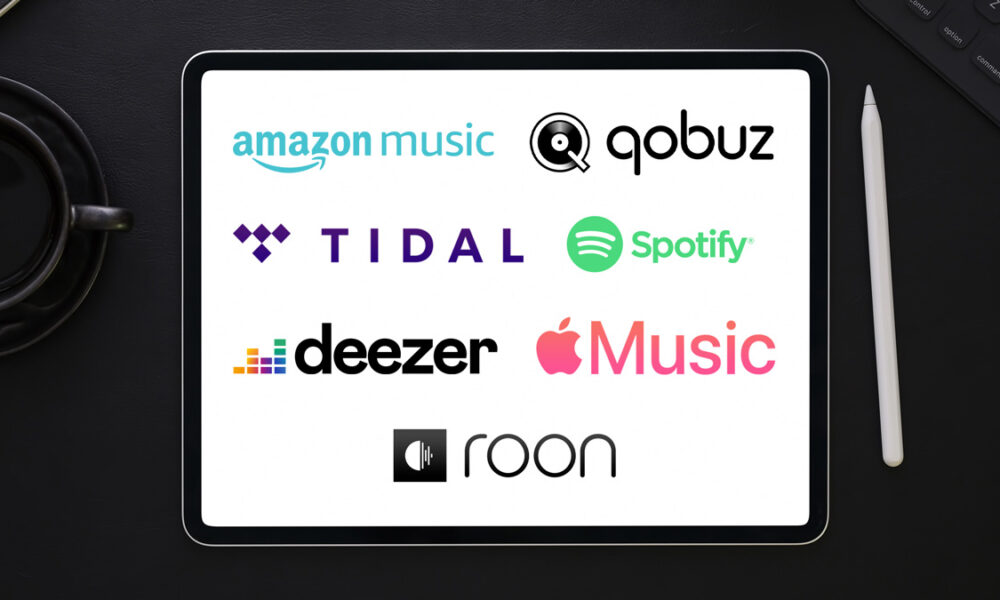Embark on a journey through the realm of high-end audio streaming services in this guide. We’ll delve into the crème de la crème of platforms including Spotify, Qobuz, Tidal, and more. Whether you’re an audiophile veteran or a newcomer, this article guides you through premier options, file types and streaming quality options, helping you elevate your listening experience and immerse in sonic excellence.

Streaming is the overwhelmingly popular choice for music listeners today. Everyone knows the big hitters, Spotify, Apple, and Amazon, but what are the options for those looking to stream their music in the most Hi-Fi way possible?
Identifying a Hi-Fi streaming platform really only involves one key thing, files. File types are the key differentiator between your average Joe streaming service and the best of the best. The majority of mainstream streaming services use lossy files. The lossy format can be something like MP3 or AAC, which tends to be the most compressed option. Some platforms, however, opt for the real stuff, the cream of the crop; lossless and uncompressed.
We’ve been in the audio space for over 40 years, decoding and deciphering Hi-Fi knowledge for audiophiles of all levels, and streaming is no exception. We’ll focus on streaming platforms and what makes them good, bad, and the best.
In relation to listeners or streamers, a music streaming service offers a range of features and benefits, enhancing how people discover, access, and enjoy music. Here's what a music streaming service should offer its users:
“It is quite easy to get overwhelmed by the sheer number of options available and spend money on services that do not meet our needs or fall short of what should be expected.”
Music streaming services cater to the preferences and convenience of listeners in unique ways, but they all should provide all or most of these features.
A music streaming service work like middlemen between musical artists, record companies, and their audiences (aka the listeners). While this may not immediately evident to average listeners, this relationship between companies, artists, and their records labels can significantly influence the accessibility and breadth of music selection available to listeners. Here's how this dynamic typically works in relation to artists and record companies:
Music Available on the App: Music streaming services provide a platform where record companies can upload and distribute their music catalogs. They work with record labels and artists to obtain licenses for the songs, allowing them to be streamed on the platform.
Artists Getting Paid: When users stream songs on the platform, the streaming service generates revenue through subscription fees, advertising, or a combination of both. A portion of this revenue is paid to the rights holders, including artists, songwriters, and record companies, generally based on the number of streams.
Exposure and Outreach: Music streaming services offer musicians and record companies the opportunity to reach vast global audiences effectively. This exposure helps both established and emerging talents gain new fans and expand their reach beyond traditional means. They provide a way for artists to find listeners of similar and related artists for more direct exposure.
Learning About Listeners: Streaming services collect data on user behavior, such as listening habits and preferences. They provide artists and record companies with valuable insights into their audience, which can help make informed decisions about marketing, touring, and creating new content.
Playlists and Curation: Many streaming platforms create and promote playlists curated by human editors or algorithms. Artists and record companies strive to include their songs in popular playlists, which can significantly increase their visibility and stream counts.
Promotional Help: Some music streaming services offer promotional opportunities, such as featuring new releases on their homepages or in curated playlists.
Copyright Protection: Streaming services employ content recognition technologies to identify and prevent unauthorized uploads of copyrighted music. This helps protect artists and record companies from piracy and ensures they receive appropriate royalties for their work, allowing them to focus on creating new music.
Anyone Can Share: Some music streaming services offer direct upload options, allowing independent artists to release their music without needing a traditional record label. This democratizes the music industry and gives more artists an opportunity to share their work with a wider audience.
Music apps are a big part of how we enjoy music today. They help singers and music companies share their songs with us and make sure they get paid for their hard work. This affects the kind of music we can listen to on these apps.
Music streaming relies on file compression. As audio is digitized, it’s essentially turned into strings of code your computer can process and then share. After it’s digitized, it’s saved as a file, which can take up space. To save space and make some files easier to share, they get compressed, essentially removing enough extra data in the file to save space but reducing overall quality. If you’ve ever shared an image from your camera or your phone to social media or text messaging, you might notice your photo looks of slightly worse quality than the original shot; this is an excellent example of how compression works.
Some streaming services are dedicated to providing listeners with the best possible version of existing audio files, and those are the platforms we’ll mainly focus on today. By using a majority of lossless or uncompressed files, these platforms sacrifice space to deliver the best streaming has to offer.
With the growth of music streaming, the market has exploded with new services all battling it out to be the best. While some services have focused more on popularity and being social media friendly with lots of shareability, others are tackling audio differently: through lossless audio of the highest form. So, let’s go through the top services.

Arguably, the most popular streaming platforms out there, Spotify has hundreds of millions of users daily worldwide. It’s the quintessential all-rounder that basically anyone can download and start using right away.
Made famous for creating playlists tailored to users listening experiences, you might be surprised to know that, unfortunately, when it comes to fidelity, Spotify is one of the least Hi-Fi options.
Spotify prioritizes shareability over all else, which is fantastic for exploring and connecting with other music lovers, but if you're looking to stream from Hi-Fi gear and get the most out of your sound, you won’t find it here. Using lossy files and a lack of options to prioritize other file types, Spotify often won’t be the audiophile's first choice.
Max Streaming Quality: 320kbs
Supported Files: Ogg Vorbis, AAC, HE-AACv2
Check it out: Spotify Website

Apple Music does offer high-quality audio streaming. While other dedicated Hi-Fi streaming services offer higher quality, Apple Music is still a solid option for those who are looking for good audio quality. In addition to its high-quality audio streaming, Apple Music also has other features that make it a great service.
For example, it offers curated playlists and personalized recommendations by artists themselves. Another advantage of Apple Music is that it improves the quality of platforms that use lossy files like MP3 or AAC. This means that even if you listen to music on a platform that doesn't support high-fidelity audio, you can still enjoy better audio quality with Apple Music.
Max Streaming Quality: 16bit / 192kHz
Supported Files: AAC, ALAC
Check it out: Apple Music

One solid and arguably more convenient option is to go with Amazon Music HD, which provides higher-quality audio streaming. It is noteworthy to mention that Amazon is well-known for its bundling deals with other subscriptions.
So, if you are already subscribed to Amazon Prime, then you are entitled to a "free" subscription to Amazon Music. This is a great way to get started with Amazon Music HD and explore its features. Even better, with Amazon Music HD, you can access top-notch music and a vast library of songs, playlists, and curated radio stations that cater to your musical tastes and preferences.
Max Streaming Quality: 24bit / 192kHz
Supported Files: FLAC
Check it out: Amazon Music

Tidal has quickly become the go-to source for audiophiles and music enthusiasts alike, thanks to its commitment to providing uncompressed and lossless file types. Tidal has established itself as one of the best music streaming services by offering a growing catalog of music and some of the best streaming quality in the game.
With Tidal, you can truly immerse yourself in your favorite music, hearing every detail as the artist intended it to be heard. Whether you want to discover new music or rediscover old favorites, Tidal offers a comprehensive library that will satisfy even the most discerning listener.
Max Streaming Quality: 24bit / 96kHz (if you subscribe to Tidal HiFi Plus)
Support Files: AAC, ALAC, FLAC
Check it out: Tidal Website
 Qobuz has become a fan favorite among audiophiles due to its exceptional sound quality. The company has prioritized providing high-resolution audio files to its users, offering a superior listening experience that sets it apart from other streaming services.
Qobuz has become a fan favorite among audiophiles due to its exceptional sound quality. The company has prioritized providing high-resolution audio files to its users, offering a superior listening experience that sets it apart from other streaming services.
Qobuz has also gained a reputation for its extensive and truly global music library. In addition, the platform offers exclusive content, such as interviews and live performances, that cannot be found anywhere else.
Max Streaming Quality: 24bit / 192kHz
Support Files: AIFF, ALAC, FLAC, WAV, WMA Lossless
Check it out: Qobuz Website
 Roon is an innovative streaming platform that has been gaining popularity among audiophiles due to its unique features and user-friendly interface. As an all-in-one-based streaming platform, Roon sets itself apart by being more than just an audio streaming service. It acts as a central hub for all your Hi-Fi sources, making it easier for users to manage and organize their music library. This feature is particularly beneficial for audiophiles who have a collection of subscriptions to different platforms.
Roon is an innovative streaming platform that has been gaining popularity among audiophiles due to its unique features and user-friendly interface. As an all-in-one-based streaming platform, Roon sets itself apart by being more than just an audio streaming service. It acts as a central hub for all your Hi-Fi sources, making it easier for users to manage and organize their music library. This feature is particularly beneficial for audiophiles who have a collection of subscriptions to different platforms.
One of Roon's most significant advantages is its compatibility with various high-end streamers, making it an ideal choice for users who are looking for a comprehensive solution for their streaming needs. Users can also enjoy the best of every platform without any hassle, allowing them to get the most out of their Hi-Fi sources.
Another standout feature is its enhanced music library management tools. With Roon, users can easily organize their music library and access their favorite songs with ease. This feature is particularly useful for users with a vast music library, making finding the music they want to listen to easier.
Max Streaming Quality: 32bit / 768kHz
Support Files: WAV, WAV64, AIFF, FLAC, ALAC (Apple Lossless), DFF, DSF, OGG, MP3, and AAC
Check it out: Roon Website
 Deezer is a fantastic choice for those who love high-fidelity streaming. With its vast music library and unwavering commitment to delivering exceptional sound quality, Deezer has quickly become one of the most popular platforms for music lovers worldwide.
Deezer is a fantastic choice for those who love high-fidelity streaming. With its vast music library and unwavering commitment to delivering exceptional sound quality, Deezer has quickly become one of the most popular platforms for music lovers worldwide.
If you're looking for a way to stream music in stunning detail and clarity, then Deezer is the perfect choice. It has a simple, intuitive interface and easy-to-use features; you can find and enjoy your favorite songs with just a few clicks of a button. Plus, with its advanced algorithms and smart recommendations, Deezer will help you discover new music.
Max Streaming Quality: 16bit / 44.1kHz
Supported Files: FLAC
Check it out: Deezer Website
In today's world, a considerable portion of our entertainment consumption is delivered by subscription-based services. It’s easy to get overwhelmed by the sheer number of options available and spend money on services that do not meet our needs or fall short of what should be expected. By understanding the options available to us, what they can offer, and if they can provide the level of fidelity required to optimize Hi-Fi systems, you can make informed decisions and get the most out of a subscription-based service.